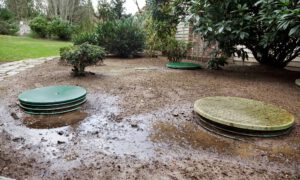When you notice your water meter running at an unusually high rate, it could be a sign of Yard Leaks. The red triangle and the silver dial on the meter should be spinning. If they are not, the problem could be in the water pipe connecting your home to the shut-off valve in the yard. If you notice mud and soft spots in the grass, the area could be leaking water. You should immediately contact a plumber or water company to have the leak fixed.

In addition to standing water, you may also notice a lush patch of grass. The grass grows faster when there is extra moisture in the soil. If the leak is in a drainage pipe, you may even notice a faint hissing sound. Plumbers In Spring TX use the necessary tools to locate and repair a leak. In addition, he can also replace your turf or soil if the leak is under a footpath or landscape rock.
The most obvious sign of a leak in the yard is standing water. Standing water may be a sign of a broken underground drainage line. Other signs of a leak include green grass growing faster than the rest of the yard. This could indicate a leak in your sprinkler system, drain field, or septic tank. A professional can pinpoint the exact location of the leak and repair the pipe so that it doesn’t happen again.
Another tell-tale sign of a yard leak is a rising water bill. If the amount is increasing more than normal, it could be a hidden leak on the main water line. You may notice an increase in your water bill without any obvious signs of a leak. However, if you notice an increase in your water bill, you should call a plumber to identify the source of the leak and fix it. They can also repair the damaged area to save you money.
Other signs of a leak in the yard include puddles and small valleys. In addition to water stains, you may also notice a foul odor. Water can also cause soil to become marshy or expand. Regardless of the cause, repairing a yard leak is difficult and expensive. If left untreated, it can lead to mold growth. Yard leaks need professional attention to prevent costly repairs and water damage.
To find the source of a leak, check the main water shut-off valve. Most water shutoff valves are located in the basement or along an exterior wall. Be sure to turn the valve slowly without damaging it. You should also check the water meter’s metal lid. If you have to replace it, make sure to contact a plumber. If you notice any of the above symptoms, you need to fix the problem as soon as possible.
Another common cause of Yard Leaks is broken sewer lines. Water can also come from the ground if the water table is high. To fix this problem, you should install in-ground irrigation. If the water table is high, you should also check for adequate yard drainage. If the water table is high, then the water will be coming from the sewer line. A leaky sewer line may also be the cause of the problem. When the problem is in the yard, it may be the result of a faulty yard drain.
The first sign of waterlogging may be a high water bill. Although it may take some time for the soil to become saturated, water pressure can decrease. If you hear sounds of running water, you may have a leak. If you suspect a leak, call a plumber immediately. If the water pressure is low, the pipes may be clogged, and the water will not flow properly. When the water pressure is low, you may be experiencing a leak.
Identifying the source of Yard Leaks is a challenging task. Using a specialized dye to check the line is a good way to pinpoint the source of the problem. If you suspect sewer line leakage, you need to call a plumber to have the area fixed as soon as possible. If you don’t have a professional plumber on hand, you may have to deal with a soaring water bill.
